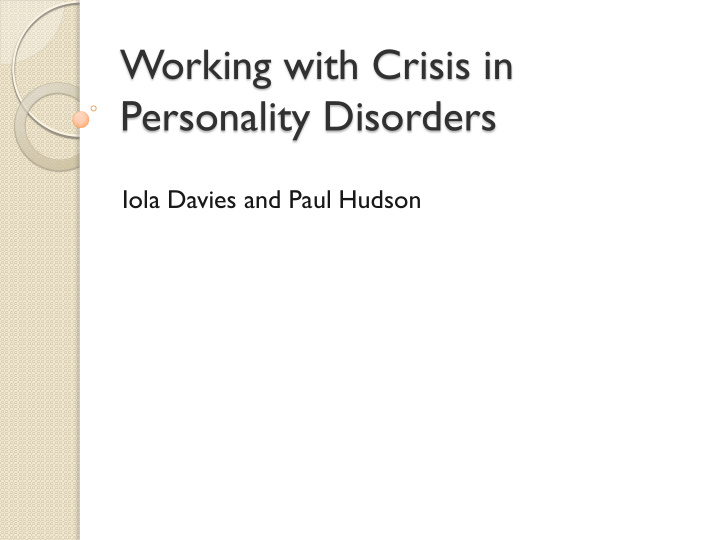



Working with Crisis in Personality Disorders Iola Davies and Paul Hudson
Crisis Care concordat :Mental Health;Feb 2014 The Mental Health Crisis Care Concordat is a national agreement between services and agencies involved in the care and support of people in crisis. It sets out how organisations will work together better to make sure that people get the help they need when they are having a mental health crisis. http://www.crisiscareconcordat.org.uk
4 main foci Access to support before crisis point – making sure people with mental health problems can get help 24 hours a day and that when they ask for help, they are taken seriously. Urgent and emergency access to crisis care – making sure that a mental health crisis is treated with the same urgency as a physical health emergency. Quality of treatment and care when in crisis – making sure that people are treated with dignity and respect, in a therapeutic environment. Recovery and staying well – preventing future crises by making sure people are referred to appropriate services.
Declarations, action plans and action! 96 collaborative action plans covering 152 local authority areas across England (Jim Symington 2015) National Police Chiefs’ Council – Police custody used 4,537 times in 2014/15, down from 6,667 times in previous year. Under 18s, a 37% reduction from 256 to 161. Bristol street triage from September
What is a crisis ? Self defining Personality disorder extremes? Variable from one person to another and within one person? Self harm/suicide? Depth? Frequency? Length?
What might be helpful before a crisis? Focus 1 Better understanding of why a person might go into crisis Difficulties with emotional expression, schema triggers,anniversaries,sleep difficulties? Proactive rather than reactive services Prevention Effective person centred crisis plans drawn up in collaboration with the service user when they are not in crisis
During crisis; foci 2 and 3 Adequate and efficient use of resources Collaborative working between services Skilled workers and effective communication e.g Meeting the Challenge p.41 Consistent team working within and across services and sectors (shared plan?) Your role in the journey? Staff self awareness; stigma, understanding,reflection and support
BOUNDARY SEESAW MODEL (Hamilton 2010) Punishing Controller CONTROLLE NEGOTIATOR PACIFIER Exploitative Carer R Flexible Limits Fixed and Flexible Fixed Limits limits Involved enough to Under-involved & Over-involved & nurture & empower too controlling too placating Caring Indulging Enmeshed Abusing Abusing Dominating Controlling Caring Hamilton, L (2010). Boundary Seesaw Model: Good fences make for good neighbours. In T ennant, A. & Howells, K. (Eds.), Using Time, Not Doing Time: Practitioner Perspectives on Personality Disorder & Risk (p181-194). Chichester: Wiley-Blackwell. 8 Package developed by Laura Hamilton, Registered Forensic Psychologist, Peaks Unit, Rampton Hospital
Empowerment Effective collaborative, accessible plan? Real choice for service users? Specific individual and group needs? ‘Mental health crisis review - experiences of minorities’ (case studies and key themes) Bristol women’s crisis house: Link House 20 plus year campaign led by service users Max 4 week stay, person centred, recovery and holistic approach 10 beds opened Jan 2010,part of whole system T ender process- service users key part in all stages of the process
Recommend
More recommend